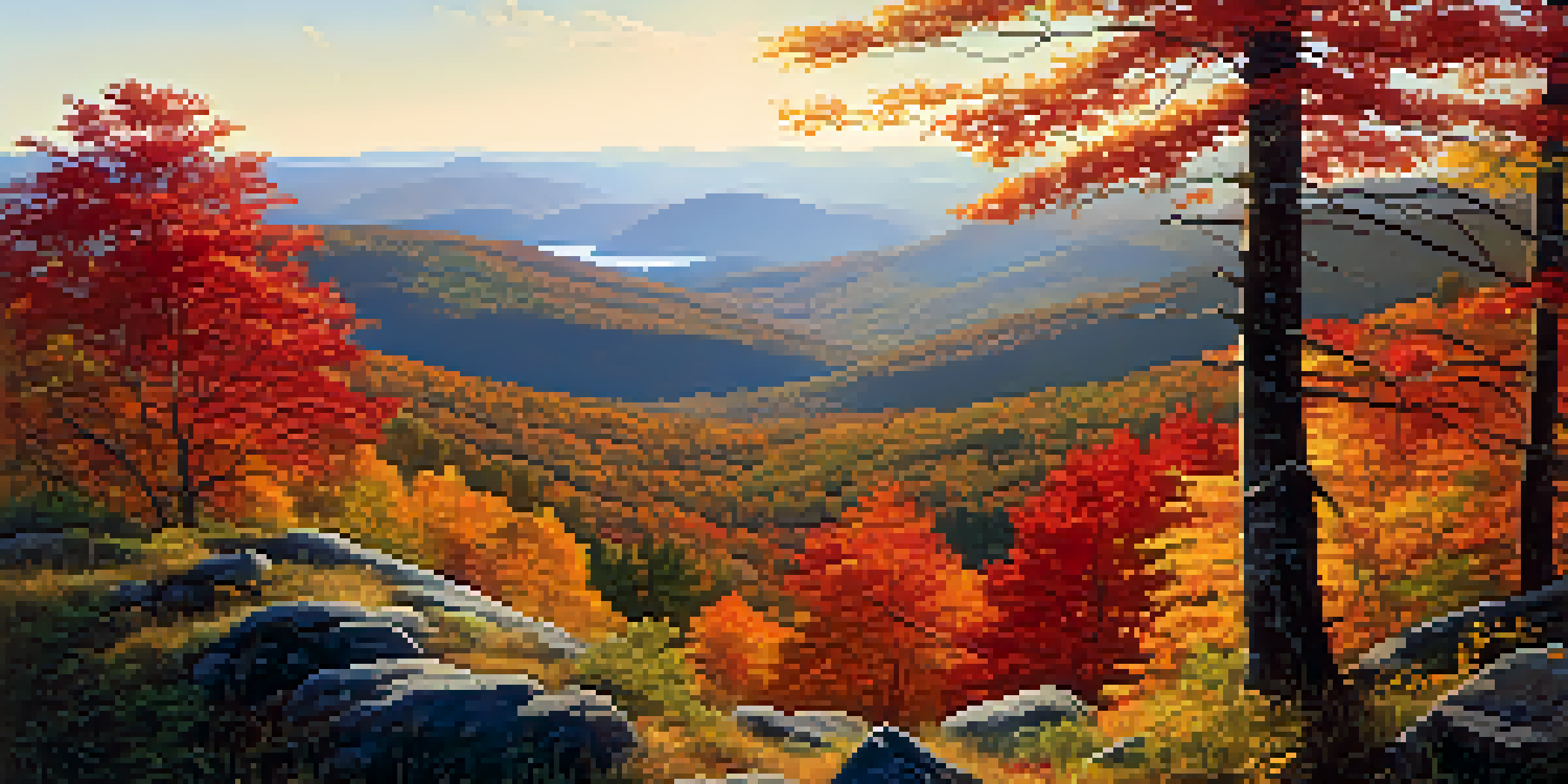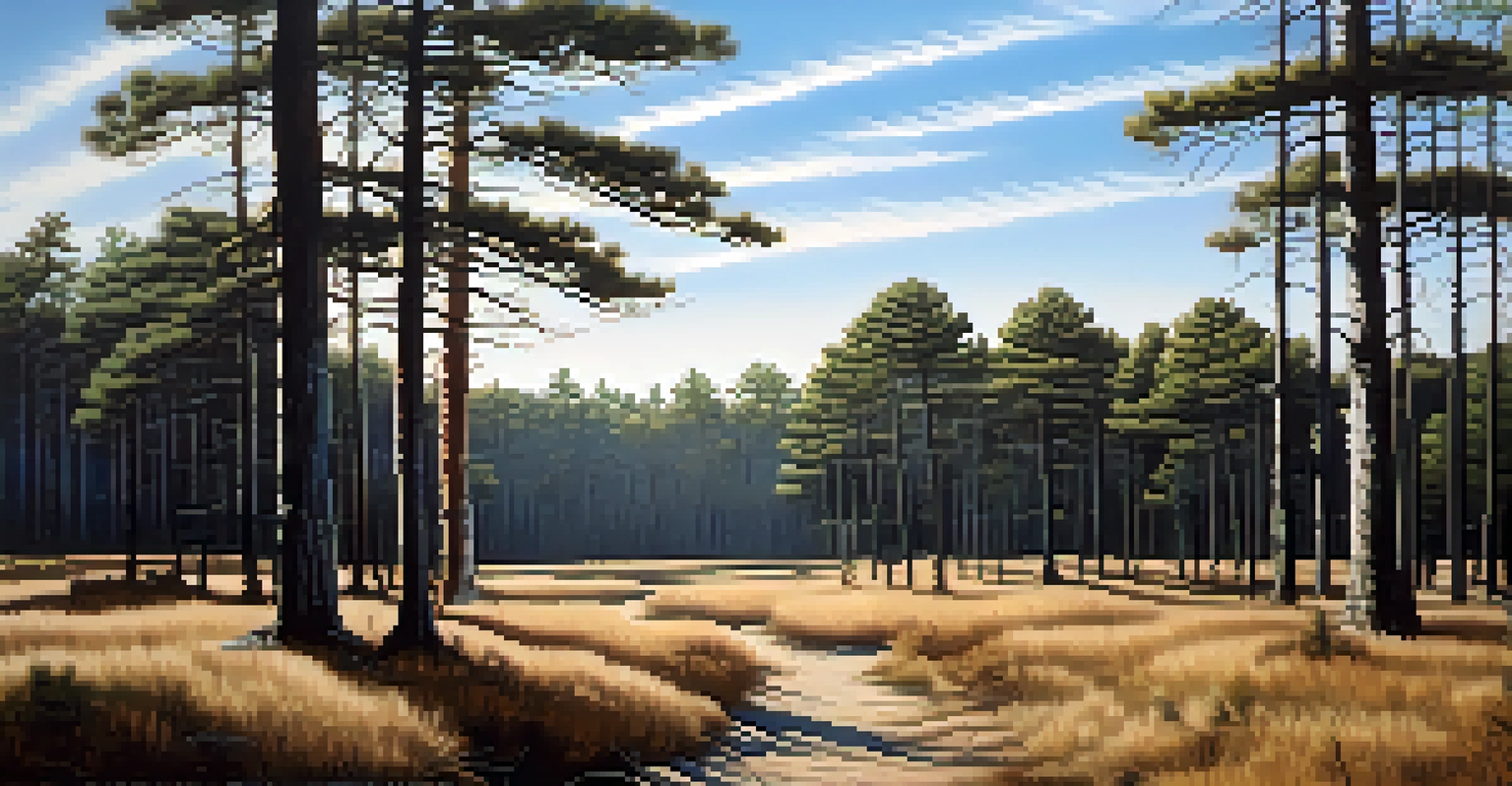Understanding New Jersey's Topography: Hills and Plains

An Overview of New Jersey's Geographical Diversity
New Jersey is often thought of as a small state, but its topography is surprisingly diverse. From rolling hills to flat plains, the landscape varies significantly across regions. This geographical diversity shapes not just the scenery but also the climate, ecology, and even the culture of the areas within the state.
Nature does not hurry, yet everything is accomplished.
The northern part of New Jersey is characterized by the rugged terrain of the Appalachian Mountains, offering picturesque views and outdoor activities. In contrast, the southern region features the sandy plains of the Pine Barrens, which are home to unique flora and fauna. This blend showcases how New Jersey's geography can appeal to a wide range of interests, from hiking to birdwatching.
Understanding this geographical tapestry is essential for appreciating the state's natural beauty. Each area offers a distinct experience, reminding us that even in a small state like New Jersey, there’s a wealth of landscapes to explore.
The Appalachian Mountains: New Jersey's Northern Peaks
The Appalachian Mountains run through the northwestern part of New Jersey, providing a striking contrast to the flatlands. This region is home to several prominent peaks, such as High Point, which stands as the highest point in the state at 1,803 feet. The mountains not only offer breathtaking views but also a variety of recreational opportunities like hiking, skiing, and camping.

The geological history of the Appalachians is fascinating, dating back millions of years. The mountains were formed through a series of geological events, including tectonic plate collisions and erosion, resulting in the rugged terrain we see today. This rich geological past adds layers of intrigue for anyone interested in natural sciences or history.
New Jersey's Diverse Landscapes
New Jersey's geography ranges from mountains to coastal plains, each offering unique recreational and ecological opportunities.
As you hike through these mountains, you may encounter diverse ecosystems, from dense forests to open meadows. This biodiversity is crucial for maintaining ecological balance and provides a habitat for countless species, making it a vital part of New Jersey's natural heritage.
The Rolling Hills of Central New Jersey
Central New Jersey is known for its charming rolling hills, which create a softer landscape compared to the rugged north. These hills are often dotted with farms, vineyards, and picturesque towns, reflecting the area's agricultural roots. The undulating terrain provides beautiful vistas, especially during autumn when the foliage transforms into a vibrant display of colors.
In every walk with nature one receives far more than he seeks.
The hills play a significant role in the local climate, influencing weather patterns and water drainage. This topography allows for fertile soil, making it ideal for agriculture. In fact, many of the state's most famous farms and wineries are located in this region, contributing to New Jersey's reputation as the 'Garden State.'
Exploring the rolling hills can be a delightful experience, whether you're biking along scenic routes or enjoying a leisurely drive. Each curve in the road reveals a new view, inviting you to appreciate the beauty of nature in a way that feels intimate and welcoming.
The Pine Barrens: A Unique and Mysterious Landscape
The Pine Barrens, located in southern New Jersey, is a unique ecosystem characterized by its sandy plains and dense forests of pine trees. This region is often shrouded in mystery, with folklore and tales of the infamous Jersey Devil adding to its allure. But beyond the myths, the Pine Barrens is a vital ecological area, home to numerous species of plants and animals that thrive in its sandy soil.
The landscape of the Pine Barrens is shaped by its history of fire and human activity. Regular wildfires help to maintain the health of the ecosystem by clearing out underbrush and allowing new growth. This dynamic relationship between fire and nature is a fascinating aspect of the Pine Barrens, showcasing how landscapes can evolve over time.
Topography Influences Ecosystems
The varied elevations and landforms in New Jersey create a rich tapestry of habitats that support diverse wildlife.
Visiting the Pine Barrens offers a chance to explore a part of New Jersey that feels untouched by the hustle and bustle of modern life. Whether you're hiking, kayaking, or simply taking in the sights, the serene beauty of this region invites you to slow down and connect with nature.
The Coastal Plains: Where Land Meets Sea
As we move towards the eastern edge of New Jersey, the landscape transitions into coastal plains. These flat, low-lying areas are characterized by their proximity to the Atlantic Ocean, offering a different kind of beauty compared to the hills and mountains. The coastal plains are vital for both ecosystems and human activities, from fishing to tourism.
New Jersey's coastline is dotted with beaches, boardwalks, and charming seaside towns, making it a popular destination for residents and visitors alike. The landscape here is shaped by both natural forces, like tides and storms, and human development. This interaction between nature and man is a constant reminder of the delicate balance we must maintain.
Exploring the coastal plains can be a delightful experience, whether it’s relaxing on the beach or enjoying water sports. The soothing sound of waves and the salty breeze create a refreshing atmosphere that invites you to unwind and enjoy the beauty of New Jersey’s shoreline.
The Importance of Topography in Ecosystem Diversity
Topography plays a crucial role in determining the types of ecosystems present in an area. In New Jersey, the varying elevations and landforms create a rich tapestry of habitats, from mountainous regions to wetlands and coastal areas. This diversity supports a wide range of wildlife, each adapted to their specific environment.
For example, the northern mountains are home to species that thrive in cooler, elevated climates, while the southern Pine Barrens support unique plants and animals that have adapted to sandy soils. This ecological variety not only enhances biodiversity but also provides essential ecosystem services, such as clean water and air.
Cultural Impact of Geography
The state's landscapes have shaped its cultural identity, influencing settlement patterns and economic activities across regions.
Understanding the relationship between topography and ecology is vital for conservation efforts. By recognizing how different landscapes support various life forms, we can better protect and manage these ecosystems for future generations to enjoy.
Cultural Influences of New Jersey's Landscapes
New Jersey's diverse topography has not only shaped its natural environment but also its culture and history. The varying landscapes have influenced everything from settlement patterns to economic activities. For instance, areas with fertile soil have historically attracted agriculture, while coastal regions have thrived on fishing and tourism.
Each region's unique characteristics contribute to a rich cultural tapestry. The mountainous north is often associated with outdoor recreation and nature conservation, while the coastal towns are known for their vibrant boardwalks and summer tourism. This blend of cultures and lifestyles reflects how geography can shape community identity.

By exploring the cultural influences of New Jersey's landscapes, we gain a deeper appreciation for the state's heritage. It's a reminder that the natural environment and human experiences are interconnected, shaping both our past and our future.
Conclusion: Appreciating New Jersey's Topographical Diversity
In conclusion, New Jersey's topography offers a fascinating blend of hills, plains, and coastlines, each contributing to the state's unique character. Understanding this diversity is essential for appreciating the natural beauty and cultural richness that New Jersey has to offer. Whether you're an outdoor enthusiast, a history buff, or a curious traveler, there's something in New Jersey's landscapes for everyone.
As we explore these various terrains, we not only connect with nature but also with the stories and histories they hold. From the rugged mountains to the serene coastal plains, each landscape invites us to discover and engage with the world around us.
So, the next time you find yourself in New Jersey, take a moment to appreciate the diverse topography. Whether you’re hiking through the hills, wandering the Pine Barrens, or relaxing on a beach, remember that you’re experiencing a piece of this state’s rich tapestry of landscapes.